| Commonwealth of Great Britain
Cymanwlad Prydain Fawr (Welsh) Timeline: German Heritage | ||||||
|---|---|---|---|---|---|---|
|
||||||
| Anthem: Land of Hope and Glory |
||||||
| Capital | London | |||||
| Official languages | English Welsh Cornish Manx |
|||||
| Religion | Protestant Christian, Catholics, Islam | |||||
| Demonym | British; Brit | |||||
| Government | Federal Parliamentary Republic | |||||
| - | President | Jack Straw | ||||
| - | Prime Minister | Andy Burnham (Progressive) | ||||
| - | Deputy Prime Minister | Caroline Lucas (Greens) | ||||
| Legislature | Parliament | |||||
| - | Upper house | Senate | ||||
| - | Lower house | House of Commons | ||||
| Establishment | ||||||
| - | Flight of the Royal Family | October 1917 | ||||
| - | First Republican Parliament | April 1918 | ||||
| - | Constitution Created | 12 August 1918 | ||||
| Area | ||||||
| - | Total | 230,977 km2 89,181 sq mi |
||||
| Population | ||||||
| - | 2016 estimate | 60,800,000 | ||||
| Currency | Pound (GBP; £) |
|||||
| Date formats | dd.mm.yyyy | |||||
| Drives on the | left | |||||
| Internet TLD | .gb | |||||
The Commonwealth of Great Britain, commonly known as the British Commonwealth or Great Britain, is a Sovereign Nation located in Western Europe.
The British Commonwealth consists of two constituent republics: England and Wales. Their capitals are London and Cardiff respectively. These countries have their own parliaments, which decide all affairs excluding broadcasting policy, common markets for British goods and services, the constitution, energy and defence and national security. The nearby Isle of Man, Guernsey and Jersey are not part of the Commonwealth, being dependencies with the British Government responsible for defence and international representation.
Great Britain became a de facto republic in October 1917, when the Royal Family and Imperial British Government fled Britain to Canada, and became a de jure republic in March 1918 when the position of President was created. A National Assembly was convened in Southampton, where a new constitution for Britain was written and adopted on 12 August 1918. During its early years, the British Republic faced numerous problems, including the rising of food prices, economic downturn, political extremism (with contending paramilitaries) as well as contentious relationships with the victors of the First World War.
In the middle of the 1920s, the Labour Government of Ramsay MacDonald steered Britain closer to the United States in an effort to boost the failing economy. Investment from America flooded into the Republic, and by 1929, many sectors of the British economy were heavily reliant on American support to remain sustainable. While this foreign policy endeavour did temporarily boost the British economy, when the American economy collapsed after the wall street crash, it had the adverse effect of bringing the Commonwealth’s economy crashing down. For the next decade, Britain would deeply feel the impact of the worldwide Great Depression. Britain's world trade fell by three quarters (1929–33), the output of heavy industry fell by a third, and the registered unemployed numbered six million.
The Labour Party, already electorally hurt by the 1926 General Strike, saw a massive decline in popularity as a result of the Great Depression. In 1932, Labour fell to fourth place in the general election and fell out of government. The 1932 Election also saw a rise in anti-government parties, such as the National United and Liberal Parties, and for extreme parties, such as the Communists and Fascists.
The British Commonwealth is a member of NATO, the League of United Nations, the Pan-European Community and Council of Europe.
History
1911-1914: Second Balfour Government & The Great Unrest
- For history prior to 1917, see History of the United Kingdom. For history prior to 1707, see History of the British Isles.
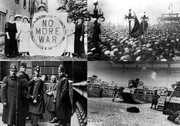
Clockwise from top right:Socialist revolts in Glasgow, Scotland, Royalist tanks in the Midlands, communists David Kirkwood and Willie Gallacher being detained, women protesting the end of the war.
Though the Conservatives had gained a majority, the period 1911-1914 was by no means plain sailing for the Balfour Government. Though many of the Liberal government’s reforms had been reversed, the political discourse that they created had deeply de-stabilised the establishment. Multiple crises hit simultaneously in 1911–1914 with serious social and political instability arising from the Irish crisis, labour unrest, the women's suffrage movements, and partisan and constitutional struggles in Parliament. The Great Unrest that followed 1910 saw over 5,000 strikes in all parts of the country. The response to these strikes often led to violence between the strikers and government - an estimated 500 people were killed as a result of the Great Unrest. In these (mostly-northern) communities, the surging Labour Party became more and more relevant as the working-class became radicalised and turned towards Labour as the left-wing alternative to the Conservatives.
1917-1918: British Revolution
After George V refused to change the royal name from Saxe-Coburg and Gotha to a less-German name, the British public started to have negative feelings toward the monarchy. The exile of Nicholas II, Tsar of Russia to Britain caused a revolutionary atmosphere to engulf major urban areas. The socialist anti-war faction of the Labour Party capitalised on this negative feeling and started to encourage a revolution to halt British involvement.
While the beginning of the British Revolution is disputed among historians, it is generally placed in August, when the largest anti-war protest, numbering about 10,000, took place in Glasgow. While it is not known whether it was a warning shot[1], it caused widespread panic and caused the more rebellious to start to fight against the local units. Some Police and Army units fired into the crowd, leading to 23 deaths and 54 injuries. The conflict, which came to be known as the Battle of George Street, sparked a number of protests and strikes which eventually began to become a real threat to the British government. Various “massacres” by the police and army caused these groups to become more aggressive and armed, especially in Scotland, South Wales and industrial areas in the North-East and West of England. In September 1917, the government provisionally moved from London, which was seeing considerable unrest and revolution, to Canterbury, Kent. Home Secretary George Cave resigned and was replaced by George Curzon, Earl Curzon of Kedleston. While Curzon attempted to destroy the strikes and revolutionary spirit, the damage had been done. By Late October, the situation was critical, and the government fled to Canada.
The Commonwealth of Britain was proclaimed and on the 15th of November, 1917, the new British republic signed for an armistice with the Central Powers. After the signing of the Treaty of Bremen in February 1918, British troops were withdrawn, causing the collapse of much of the Franco-Belgian lines. The Germans broke through the Yser Front, fully occupying Belgium. The last months of the war turned into conventional warfare, with the invading imperial troops soon breaking past the fields and trenches that they had been fighting over for almost four years. The last French defensive at the Second Battle of the Marne in March 1918 failed, leading to the quick capture and occupation of Paris. While various paramilitaries continued fighting, the French government surrendered on the 21st of March, 1918.
1918-1932: Labour Government
In the years immediately following the Labour landslide of 1918, the anti-socialist, middle class vote congregated around the far-right British People’s Party (BPP), led by vicious antisemite Henry Hamilton Beamish. Unlike other countries, where the far-right was largely based around fascism, the BPP can be described as a (admittedly populist) extreme national conservative and nationalist party. The BPP claimed the Britain had been stabbed in the back by two main culprits, the Jews and the socialists, who had supposedly destroyed Britain’s international reputation. The BPP supported a restoration of the British Monarchy and Empire, a “restoration to normality”, and a reversal of most of Labour’s key policies - such as free trade, economic interventionism and higher taxes. By means of its propaganda wing, “The Britons”, the BPP gathered an increasingly dedicated following, leading to it becoming the second largest party after the British general election, 1923, gaining 23.4% of the vote.
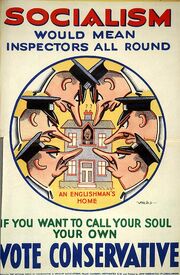
Conservative electoral poster from 1924.
The new British republic was dominated by the Labour Party, with the joint renaming conservative-liberal coalition as opposition. Many of the government, the House of Lords and richer families had fled with the royal family to Canada leaving a notable void in the mainly wealthier Conservative party. With the most prominent leaders absent, the reins of the Conservative Party were placed into the hands of George Tryon, a relative unknown who had first been elected in 1910. In 1925, the Liberal Party led by Winston Churchill united with the remnants of the Conservatives, forming the Centre Party, which aimed to unify the Anti-Socialist (yet - reformist) vote.
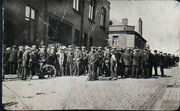
Strikers outside the Miners’ Hall in Tyldesley during the strike.
In May of 1926, a general strike was was called by the General Council of the Trades Union Congress (TUC) in an unsuccessful attempt to force the British government to act to prevent wage reduction and worsening conditions for 1.2 million locked-out coal miners. The decision to call a strike against the sitting Labour government can be tied to the historic rivalry between left-wing movements in the aftermath of the 1917 Revolution. A more prominent faction in the TUC disliked Macdonald’s Labour due to its commitment to “gradual socialism”, even during the revolution, which was argued to have been a prime chance for the establishement of a socialist society. Some 1.7 million workers went out, especially in transport and heavy industry. The government was prepared and enlisted middle class volunteers to maintain essential services. There was little violence and the TUC gave up in defeat. Though nine days in, the TUC leadership knew 'the government could hold out longer than the workers', it was perceived at the time as a 'brilliant failure'. Though the Labour Government ultimately won out against the strikers, it marked the beginning of the end for the party. Many unions, the key supporters of the Labour Party, turned against the party due to its passive resistance against the strikers. Labour scraped by a limited victory in the ensuing 1928 British General Election and saw a swing of voters defect to the Scottish Communist Party or the CPGB.
The Great Depression originated in Germany in early 1930 and quickly spread to the world. Britain, under the war reparations of the Treaty of Bremen, was economically tied to the United States to keep the British economy afloat, which caused the economy to plummet. The output of heavy industry fell by a third and employment profits plunged in nearly all sectors. At the depth in summer 1932, registered unemployed numbered 6 million, and many more had only part-time employment. The Labour Party, who was in government during the Great Depression, became blamed for its ineffectiveness, and saw a massive loss in 1932 to the Centre Party. By 1935, the Labour Party had disintegrated and split into its moderate, extreme, and interventionist wings. Many moderates joined with the remainder of Lloyd George’s Liberal Party to form the Free Democratic Party (FDP), while others joined the Centre Party or the CPGB.
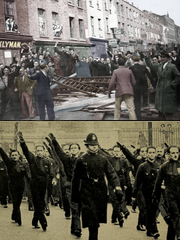
Pictured: Anti-Fascists block the road for Scottish Fascists a few minutes before a brawl (top) Members of the fascist SDFP march through Glasgow during the 1930s (bottom)
1932-1942: Churchill Government & Instability
In the 1930s, Britain saw a sharp increase in support for political extremes - many felt disillusioned with the economic and political system and wanted radical change. Unlike the Britain of years prior, the British people were much more inclined toward political change, providing an impetus to radical parties. In the 1932 Election, the CPBG and British Fascists gained 9.6 percent and five percent of the vote respectively. In Scotland, violence erupted on the streets of Glasgow between supporters of the Scottish Communist Party Andy Scottish Democratic Fascist Party.
- ”Millions of Men died for a futile cause in 1914. Why would Britain put itself through that again? If Britain returns to this expansionist and aggressive path, you will see more fatherless children, more grieving widows and mothers and another “Lost Generation” - why would you support that? - Oswald Mosley, 1942.
As war erupted in Europe in 1941, the British Government was quick to declare neutrality. However, the faction surrounding PM Churchill still supported intervention to help crush the threat of communism. Indeed, the militaristic faction prompted future prime minister Oswald Mosley to resign as Chancellor of the Exchequer in 1940 as a protest of the Government’s policy of British rearmament. Throughout the early years of the war, the debate surrounding British intervention was incredibly competitive - often, sides were taken, not due to any political affiliation, but due to personal beliefs, which made the debate more complicated. Ideologically, Britain was also divided as to which side of the conflict to join. On the one side stood France and Russia, at a time when anti-communism was strong, and on the other stood the Germans, whose wartime conduct was still bitterly remembered and resented. The interventionist debate came to a climax in 1942, when the (prescheduled) general election was held. World War II became the key issue in the election campaign -
1947-1952: Bevin & Bevan Governments
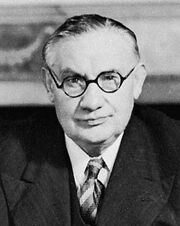
Ernest Bevin (1881-1951), Bevin led the Progressives to victory in 1947 and helped establish the new welfare state.
In the British general election, 1947, the Centre Party, now led by Ernest Brown, faced the first truly competitive election since 1928. After 15 years of Centre Party rule, voters were experiencing a level of voter fatigue, and the Progressive Party, led by Ernest Bevin, had firmly established itself as the predominant left-wing opposition in Britain. The Centre Party’s campaign was mostly based on its previous good record during the 1930s, as well as a large use of anti-socialist rhetoric, in an attempt to capitalise on public fears after World War II - Brown claimed that the Progressives “would have to use some form of Cheka to impose socialism on Britain”. The Progressive campaign was based around the plans for the new welfare state, such as modern housing, full employment, and the creation of a National Health Service. Bevin also stressed his lifelong opposition to communism and commitment to democracy in an attempt to calm anti-socialist fears. The Country Party attempted to distance itself from Brown and developed an unusually right-wing manifesto, positioning itself as the main opponent of totalitarian socialism. Ultimately, the Progressive Party was successful in the election, gaining 45.5% of the vote and forming a new government.
The party quickly nationalised critical sectors of the economy, especially declining industries. The Bank of England was nationalised along with railways (see Transport Act 1947), coal mining, public utilities and heavy industry. The most controversial case was the takeover of the highly profitable iron and steel industry, which was opposed and finally reversed by the Centre Party. A comprehensive welfare state was created also with the National Insurance Act 1948, in which people in work paid a flat rate of national insurance. In return, they (and the wives of male contributors) were eligible for flat-rate pensions, sickness benefit, unemployment benefit, and funeral benefit. Various other pieces of legislation provided for child benefit and support for people with no other source of income.
In the estimation of historians, and later politicians of the major parties, the most successful and permanent program was the creation of a National Health Service which started operations in 1949. It entitled all citizens to healthcare, which, funded by taxation, was free at the point of delivery. The opposition from physicians was bought off by allowing them to keep lucrative private practices on the side. All hospitals were nationalized and brought into the system. Michael Foot states that Minister for Health Aneurin Bevan had to persuade "the most conservative and respected profession in the country to accept and operate the Progressive government's most intrinsically socialist proposition. In the end historians give Bevan the major credit for the success.
One of the main achievements of Attlee's government was the maintenance of near full employment. The government maintained most of the wartime controls over the economy, including control over the allocation of materials and manpower, and unemployment rarely rose above 500,000, or 3% of the total workforce. In fact labour shortages proved to be more of a problem. One area where the government was not quite as successful was in housing, which was also the responsibility of Aneurin Bevan. The government had a target to build 400,000 new houses a year to replace those which had been destroyed in the war, but shortages of materials and manpower meant that less than half this number were built.
Flags

| |
| Name | The Republican Tricolour |
| Use | National flag and civil and state ensign |
| Proportion | 1:2 |
| Adopted | 1917 |
| Design | A horizontal triband of red, white, and green. |
| Designed by | Unknown (c.1816) |
The national flag of Britain, frequently referred to as the British tricolour, is the national flag of the British Commonwealth. The flag itself is a horizontal tricolour of red, white and green. The proportions of the flag are 1:2 (that is to say, flown horizontally, the flag is half as high as it is wide).
While the true historical meaning and symbolism behind the flag is debated, its official symbolism was outlined in the Proclamation of a British Republic:
- “The British Republic uses the historical symbol of republicanism and worker revolution...the Red-White-Green Tricolour of Chartist fame...the red symbolises the workers of our islands...the white, the desire for peace...the green symbolises the green fields of our islands and those who live and work on them”
Federal Divisions
The British Constitution of 1918 created “a fundamentally federal union of equal republics”, made up of the three republics of England, Wales and Scotland, as well as the directly administered islands of Mann, Jersey and Guernsey. The Constitution made provision for “home rule for any of the republics” in the form of a “regional parliament”. Scotland became the first republic to re-establish a regional Scottish Parliament, in 1923. Wales established the Senedd Cymru (Welsh Assembly) in 1970, and England re-established its own parliament in 1999. Both the Channel Islands and the Isle of Man gained recognition as union republics in 1997, as a result of the then-Prime Minister Malcolm Bruce’s pledged devolution reforms. The Manx Tynwald was reestablished, and National Assemblies were created for the Channel Islands, which collectively runs all the seven Channel Islands. Since the 2016 Scottish Withdrawal, there are only four republics - England, Wales, the Isle of Man, and the Channel Islands. Though London and Cornwall are not republics, they effectively function as fifth and sixth republics of the commonwealth through the devolved London Assembly and Cornish Assembly (Senedh Kernow)
Politics
Progressive Party
British Commonwealth (German Heritage) The Progressives | |
|---|---|
| Leader | Andy Burnham |
| Formed from: | Labour Party Liberal Party |
| Founded | 1931 (as New Party) |
| Ideology | Social Democracy
Factions: Social Conservatism Pro-Europeanism Democratic Socialism Economic Conservatism |
| Political position | Centre-Left |
| European affiliation | Non-Inscrits |
| Colors | Amber |
| Parliament | 265 / 808 |
- Labour Party
- Free Democratic Party
New Democrats
British Commonwealth (German Heritage) New Democrats | |
|---|---|
| Leader | Nick Clegg |
| Formed from: | Free Democratic Party (1968-1982) Social Democratic Party (UK) |
| Founded | 1982 |
| Ideology | Social Liberalism Economic Liberalism Pro-Europeanism |
| Political position | Centre to Centre-Right |
| European affiliation | Renew Europe |
| Colors | Light Blue |
| Parliament | 200 / 808 |
The New Democratic Party (NDP)
National Party
British Commonwealth (German Heritage) | |
|---|---|
| Leader | Boris Johnson |
| Merger of | Conservative Party Liberal Party (Right-Wing Faction) |
| Founded | 1925 (as National United) |
| Ideology | Conservatism British Unionism Economic Liberalism Factions: Euroscepticism Pro-Europeanism Social Conservatism |
| Political position | Centre-Right to Right-wing |
| Colors | Blue |
| Parliament | 191 / 808 |
The National Party, known colloquially as the Nats or Tories, is a centre-right to right-wing political party in the British Commonwealth.
After serving most recently from 2012-2017 in Government under the leadership of David Cameron, the National Party has been the Official Opposition and second-largest party in parliament since the British General Election, 2017. Under Boris Johnson, elected as leader in 2017, the Party has seen a perceived shift rightward, a move seen as an attempt to slow the momentum of Forward Britain. Foundation: (1925-1928) Opposing Labour: (1928-1932) Churchill Government: (1932-1942) In Opposition: (1942-1952) Mosley Government: (1952-1962) Powell Government: (1972-1982) Opposing the Left: (1982-1992)
Momentum
British Commonwealth (German Heritage) “For the Many, Not the Few” | |
|---|---|
| Leader | Jeremy Corbyn |
| Formed from: | Progressive Party Green Party (Left-Factions) |
| Founded | 2 November 2011 |
| Membership (2020) | 120,000 |
| Ideology | Anti-Austerity Left-Wing Populism Democratic Socialism Social Democracy Euroscepticism |
| Political position | Left-Wing |
| European affiliation | GUE/NGL |
| Colors | Purple |
| Slogan | “For the Many, Not the Few” |
| Parliament | 75 / 808 |
| Pan-European Parliament (British Seats) | 12 / 64 |
Momentum is a political party in Britain founded in November 2011 by Left-wing defectors from the Progressive Party in the aftermath of the 2011 Anti-Austerity Protests. Momentum is a left-wing populist party with rhetoric rooted in anti-austerity and anti-establishment views.
Formed in 2011, Momentum surged in opinion polls for the British General election, 2012, averaging roughly 14 percent, beating the third-Party FDP in most polls. As expected, Mometum became the third-largest party in parliament after the election, gathering 15.4 percent of the vote.
Greens
British Commonwealth (German Heritage) | |
|---|---|
| Leader | Molly Scott Cato |
| Formed from: | Ecology Party |
| Founded | 1989 |
| Youth wing | Young Greens |
| Ideology | Social Liberalism Green Politics Pro-Europeanism Factions: Eco-Socialism Democratic Socialism |
| Political position | Centre-Left |
| European affiliation | European Green Party |
| Colors | Green |
| Parliament | 116 / 808 |
| Pan-European Parliament (British Seats) | 16 / 61 |
The Green Party of England and Wales (also known as the Green Party, Greens, or GPEW; Welsh: Plaid Werdd Cymru a Lloegr) is a green, left-of-centre political party in Britain. Since 2017, the Green Party has served as a coalition partner with the Progressives in the First Burnham Ministry.
Under the leadership of Sara Parkin (1989-2005), the Green Party shifted toward the political centre, attempting to broaden its electoral appeal and distance itself from its eco-socialist, protester background. In 1997, the Green Party rose to third place, gathering a small but respectable 7.7 percent of the vote and seats. The Green Party spent the next decade in a governing coalition agreement with Tony Blair’s Progressive Party, before leaving the coalition in 2009 due to the Brown Government’s austerity measures after the 2008 Financial Crisis.
- 1992: 4.4 percent
- 1997: 7.7 percent
- 2002: 10.6 percent
- 2007: 8.1 percent
- 2012: 6.3 percent
- 2017: 14.4 percent
Regionalist Coalition
British Commonwealth (German Heritage) The Regionalists | |
|---|---|
| Leader: | Collective Leadership |
| Preceded by: | Mebyon Kernow Yorkshire Party North East Party Wessex Regionalists |
| Founded | 2014 |
| Ideology | Regionalism (since 2019) Social Democracy |
| Political position | Centre-Left |
| European affiliation | European Free Alliance |
| Colors | Gold |
| Parliament | 2 / 808 |
| Local Government in Yorkshire | 23 / 1,309 |
| Cornish County Council | 21 / 123 |
Former Political Parties
Centre Party
British Commonwealth (German Heritage) | |
|---|---|
| Leaders: | Winston Churchill Ernest Brown Oswald Mosley Rab Butler Enoch Powell |
| Formed from: | Conservative Party Liberal Party |
| Succeeded by: | National Party New Democratic Party |
| Founded | 1 July 1925 |
| Dissolved | 2 November 1968 |
| Ideology | One-Nation Conservatism New Liberalism Keynesian economics Factions: Conservatism Social Democracy |
| Political position | Big tent (1925-1967) Right-Wing (1967-) |
| Colors | Green |
| Parliament of 1937 | 1 / 1 |
The British Centre Party was a centre-left-leaning political party in Britain.
- 1928:
- 1932: 53.6%
- 1937: 56.6%
- 1942: 40.3%
- 1947: 48.2%
- 1952:
- 1957:
- 1962:
- 1967:
| ||||||||||||||||||||
| ||||||||||||||||||||
- ↑ The various eyewitness accounts of the event are unclear and conflict with each other. According to official army records, it was a warning shot.




